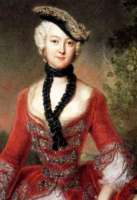| INDEX | 1300-1599 | 1600s | 1700s | 1800s | 1900s | CROSS-ERA | ETHNO | |
| MISCELLANY | CONTACT | SEARCH | |
|
|
 As
we have already seen, it was worn by royal and noble ladies and sometimes the
upper middle class.
As
we have already seen, it was worn by royal and noble ladies and sometimes the
upper middle class.
The occasion is hard to tell from the paintings, but we can safely assume that either French court style or the Allemande was worn for official, formal court functions. Receptions come to mind, such as today's summits, as well as ceremonies such as coronations, marriages and the like. And of course portrait sittings. Official portraits of royalty and nobility invariably feature one of the two styles.
But the more casual styles, and the frenquency with which they appear, suggest that the allemande was also worn for non-formal occasions. Miss Voss on the left, for example, is wearing one underneath her hunting jacket (do you see the tip of the bodice peeking out underneath?) . Maybe the slit-front and wrapped-front styles took the place of deshabillé at the various courts.
 One
not strictly formal - but still courtly - occasion that is relatively well documented
are rédoutes, or masked balls. The element of masquerade is often only
symbolically present in the form of small black masks; the rest of the costume
is fairly standard for the day and age. Standard rédoute costumes (see
picture to the right) of the first half of the century are typically of the
same shape as the Allemande, with the oval neckline of court dress, and made
of black fabric.
One
not strictly formal - but still courtly - occasion that is relatively well documented
are rédoutes, or masked balls. The element of masquerade is often only
symbolically present in the form of small black masks; the rest of the costume
is fairly standard for the day and age. Standard rédoute costumes (see
picture to the right) of the first half of the century are typically of the
same shape as the Allemande, with the oval neckline of court dress, and made
of black fabric.
Next chapter: What style did it develop from and what did it develop into?
Content, layout and images of this page
and any sub-page of the domains marquise.de, contouche.de, lumieres.de, manteau.de and costumebase.org are copyright (c) 1997-2022 by Alexa Bender. All rights reserved. See Copyright Page. GDPO
This work is licensed under a Creative Commons License.